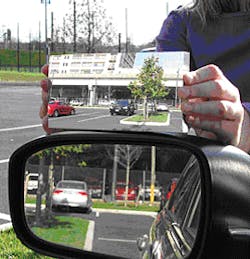Algorithm helps eliminate blind spot in mirrors
A Drexel University (Philadelphia, PA, USA) mathematics professor has developed a computer program that can create a curved mirrored surface that provides an undistorted wide angle field of view.
The patented technique has been used to create a side mirror for vehicles that eliminates the dangerous "blind spot" for drivers. The subtly curved mirror -- invented by Drexel University mathematics professor Dr. R. Andrew Hicks -- increases the field of view with minimal distortion.
Traditional flat mirrors on the driver's side of a vehicle give drivers an accurate sense of the distance of cars behind them but have a very narrow field of view. As a result, there is a region of space behind the car, known as the blind spot that drivers cannot see via either the side or rear-view mirror.
While it is not difficult to make a curved mirror that gives a wider field of view with no blind spot, this is done at the cost of introducing visual distortion.
Hicks's driver's side mirror has a field of view of about 45 degrees, compared to 15 to 17 degrees of view in a flat driver's side mirror. Unlike simple curved mirrors that can distort the perceived shape of objects, the visual distortions of shapes and straight lines in Hicks's mirror are barely detectable.
Hicks, a professor in Drexel’s College of Arts and Sciences, designed his mirror using a mathematical algorithm that precisely controls the angle of light bouncing off the curved surface of the mirror.
The algorithm is used to define the direction of each of the faces of the many smaller mirrors that comprise the curved smooth non-uniform mirror itself.
Aside from its use in mirrors, the mathematical technique could also be used in any imaging application where engineers need to redistribute radiation at a prescribed intensity from a collection of sources onto a target.
The side mirror has now received a US patent. Entitled "Wide angle substantially non-distorting mirror" (United States Patent 8180606), it can be found here.
-- by Dave Wilson, Senior Editor, Vision Systems Design
